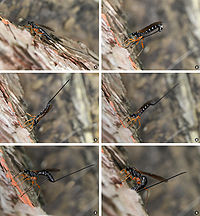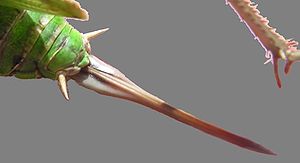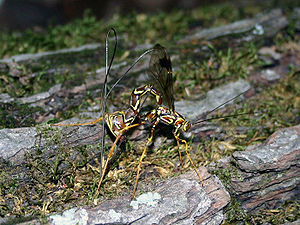- Ovipositor
-
 The process of oviposition in Dolichomitus imperator: 1 Tapping with her antennae the wasp listens for the vibrations that indicate a host is present; 2 With the longer ovipositor, the Wasp drills a hole through the bark; 3 The wasp inserts the ovipositor into the cavity which contains the host larva; 4 Making corrections; 5 Depositing eggs; 6 Depositing eggs.
The process of oviposition in Dolichomitus imperator: 1 Tapping with her antennae the wasp listens for the vibrations that indicate a host is present; 2 With the longer ovipositor, the Wasp drills a hole through the bark; 3 The wasp inserts the ovipositor into the cavity which contains the host larva; 4 Making corrections; 5 Depositing eggs; 6 Depositing eggs.
The ovipositor is an organ used by some animals for oviposition, i.e., the laying of eggs. It consists of a maximum of three pairs of appendages formed to transmit the egg, to prepare a place for it, and to place it properly. In some of the insects the organ is used merely to attach the egg to some surface, but in many parasitic species (primarily in wasps and other Hymenoptera) it is a piercing organ as well. It is used by grasshoppers to force a burrow in the earth to receive the eggs and by cicadas to pierce the wood of twigs for a similar purpose. Both long-horned grasshoppers and sawflies cut the tissues of plants by means of the ovipositor. None of these examples is quite as remarkable as the wasp genus Megarhyssa, the females of which have a slender ovipositor (terebra) several inches long that is used to drill into the wood of tree trunks[1]. These species are parasitic in the larval stage on the larvae of horntail wasps, hence the egg must be deposited directly into the host's body as it is feeding.
The sting of Hymenoptera (wasps, hornets, bees, and some ants) is also an ovipositor, in this case highly modified and associated with poison glands that are used to paralyze prey. This would allow eggs to be laid without the host fighting back, and probably also to suppress the host's immune system so that it can't destroy the eggs or shake off the paralysis.[2] However, in virtually all stinging hymenopterans, the ovipositor is no longer used for egg-laying.
Some roach-like fish, such as bitterlings, have an ovipositor as a tubular extension of the genital orifice in the breeding season for depositing eggs in the mantle cavity of the pond mussel. Seahorses have an ovipositor serving a similar purpose.
Media depictions
The Alien queen in the film Aliens is shown suspended in her nest using a giant ovipositor to lay the alien eggs. Ripley subsequently destroys it with a volley of grenades.
The BBC documentary Walking with Dinosaurs portrayed a Diplodocus mother using an ovipositor to lay her eggs.[3]
References
- ^ Sezen, Uzay. "Two ichneumon wasps competing to oviposit". http://www.vimeo.com/28911034. Retrieved 12 September 2011.
- ^ http://www.zoology.ubc.ca/~bio336/Bio336/Lectures/Lecture5/Overheads.html
- ^ Webber, Roy P. (2004). The Dinosaur Films of Ray Harryhausen. McFarland & Company. pp. 96. ISBN 0786416661.
Categories:- Reproductive system
- Fish anatomy
- Insect anatomy
Wikimedia Foundation. 2010.


